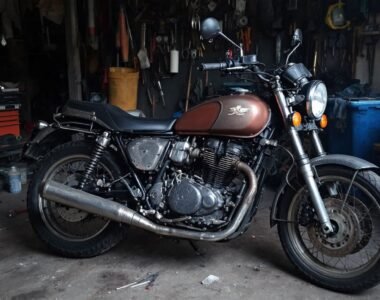
Looking to buy a salvage motorcycle? It can be a great way to save money. But, there’s a catch. You need to check it carefully before buying. A salvage title means the bike was declared a total loss by insurance.
This could be due to many reasons like an accident or flood.
One key thing is inspecting the battery for signs of corrosion. This tells you about the bike’s condition. Our article will guide you on how to inspect a salvage motorcycle before buying and spot good deals.
We cover everything from checking maintenance history to understanding state laws.
Ready? Let’s get started.
Key Takeaways
- Check the bike’s history and bring a mechanic. Learn about past crashes and repairs. A mechanic can spot problems you might miss.
- Research state laws on salvage motorcycles. Some places need extra checks before you buy.
- Look at the motorcycle closely for damage. Check parts like the battery, brakes, and tyres. Ask how well it was taken care of.
- Understand insurance for salvage bikes may be harder to get and cost more.
- Think about extra costs like repairs, checks needed by your state, or exporting the bike if selling it overseas.
What is a Salvage Title and the Importance of Inspecting a Salvage Motorcycle
A salvage title shows that a motorcycle was damaged and declared a total loss by an insurance company. Inspecting these bikes is vital, as they may have hidden issues that could cost you more later on.
Definition of a salvage title
A salvage title is given to a vehicle that has been damaged. This damage can come from accidents, floods, or fires. Once the costs of repairs exceed a certain amount of the bike’s value, it gets this special title.
A motorcycle with a salvage title may cost less than one with a clean title.
Purchasing a salvage motorcycle comes with risks. You might face hidden problems not seen at first glance. Some states have specific rules about these bikes. Inspecting the motorbike thoroughly is essential before buying it.
Check for signs of past damage and ensure all parts work correctly.
Always verify if the motorcycle has a proper title before making your purchase. Some buyers overlook this step and regret it later on. Research any state laws as well since they may require additional checks on salvaged motorcycles before you buy one.
Risks involved in buying a salvage motorcycle
Buying a salvage motorcycle can be risky. These bikes often have hidden problems. They might have been in serious accidents or suffered major damage. Inspecting a damaged bike is crucial to spot these issues early.
Functional parts may not work as they should. Check the brakes, turning signals, headlights, and tail lights carefully. Look for signs of oil leaks and check the colour of the oil too.
A faded or dark oil can mean trouble beneath the surface.
The battery requires attention as well. Signs of corrosion could indicate future failures. Tyre wear must also be even; uneven tyres can lead to unsafe riding conditions. Always ask about maintenance history to understand how well it has been cared for before purchasing a preowned motorcycle.
How to Conduct a Thorough Inspection
Start by asking for the motorcycle’s history. You need all details about past crashes and repairs. Next, bring an expert mechanic to help you check every part of the bike closely. They can spot problems that you might miss.
Ask for the vehicle’s history
Ask the seller for the motorcycle’s history. This information is vital for your assessment. Learn about any past accidents or damage. Check how often the bike was serviced and what work was done.
Look out for signs of neglect in its maintenance history.
Verify if the motorcycle has a title before making a purchase. A clear title shows it is legally owned and not stolen. If there are issues with ownership, walk away from the deal. Doing this research can help you make smart choices when inspecting a salvage motorcycle before buying.
Take an expert mechanic for a closer look
Taking an expert mechanic with you is smart. They know what to look for during a salvage motorcycle inspection. A skilled mechanic will examine the bike’s condition closely.
They can check the battery for corrosion and test other parts like brakes, lights, and signals. Asking about the maintenance history can reveal how well the bike has been cared for.
Checking these aspects helps ensure that you avoid costly repairs later on.
A good mechanic may also spot signs of oil leaks or wear on tyres quickly. They might suggest additional checks required by your state before purchase too. Bringing an expert adds confidence when buying a secondhand motorcycle.
Research state laws and regulations
State laws can affect your purchase of a salvage motorcycle. Some states require extra checks before you buy. These checks might include inspections for safety and emissions. Knowing these rules will help you avoid problems later.
Check if the state where you live has specific requirements for salvage titles. Certain regulations may dictate how to register your bike or what inspections are needed. Be aware of any paperwork necessary for buying a salvage motorcycle.
This knowledge ensures that everything is in order when it’s time to complete your purchase.
You should also look into insurance options before buying a salvaged motorbike. Many insurers treat these bikes differently than clean title bikes. Understanding this will help you plan for potential additional costs after the purchase.
Take the time to research, as this step is vital for making an informed decision about your new ride.
Tips for Spotting a Good Deal
Check if the motorcycle has been reported stolen. Research state laws to understand any restrictions on buying salvage bikes.
Check for stolen vehicles
Verify if the motorcycle you want is stolen. This step is crucial for a safe purchase. Use the Vehicle Identification Number (VIN) to search online databases or contact local law enforcement.
They can tell you if the bike has been reported stolen.
Buying a salvage motorcycle comes with risks, and this is one of them. Ensure you have all necessary documents before finalising your deal. Familiarise yourself with red flags when buying a used motorcycle to avoid future problems.
Read up on state laws
Each state has its own laws about buying salvage motorcycles. Researching these laws can help you avoid problems later. Some states may require extra checks on the motorcycle before you buy it.
Make sure to find out what documents you need for the purchase, such as a title.
Look for red flags when buying a used motorcycle as these can save you money and stress. Understanding your state’s requirements will guide your next steps in the process. It’s wise to ask about the maintenance history of the bike too.
Checking local regulations helps ensure that everything is in order. These factors are essential in assessing a damaged bike before making a decision. Having this information leads directly into obtaining insurance for your future ride.
Be prepared for thorough inspections
Thorough inspections are crucial when buying a salvage motorcycle. Inspect the battery for signs of corrosion. This helps you determine if the motorcycle is in good condition. Check the tyres closely as well.
They should be evenly worn, not focused on one side.
Look at key components during your inspection. Ensure the brakes work properly and that all lights function, including turning signals, headlights, and tail lights. Prepare the motorcycle by making sure it is cold before starting your inspection.
If available, elevate the bike with a centre stand to inspect more thoroughly.
Inquire about its maintenance history too. Ask how often repairs were done and check for oil discolouration or leaks under it. Research red flags when buying a used motorcycle so you’re informed about potential issues that may arise later on in ownership.
Final Considerations Before Making a Purchase
5. Final Considerations Before Making a Purchase: Check if you can get insurance for the bike. Think about extra costs that may arise later. Look into exporting your salvaged motorcycle if needed.
For more tips on inspecting motorcycles, keep reading!
Obtaining insurance
Getting insurance for a salvage motorcycle is important. Some companies may not insure these bikes. Check with different insurers to find one that will cover you. You need to show the title of the bike before getting insurance.
It can be hard to find good coverage at times.
Consider any extra costs related to insuring your motorcycle. Salvage bikes might have higher rates due to their past damage. Be prepared for this when budgeting for your purchase.
Make sure you understand what your policy covers and any limits it may have. After sorting out insurance, look into potential additional costs linked to owning a salvaged motorcycle.
Potential additional costs
Buying a salvage motorcycle can come with extra costs. You may need to get insurance. Many standard policies do not cover salvage bikes easily. This could mean higher premiums or even difficulty finding coverage.
Some states require more checks on the bike before purchase. These checks might cost money, so plan for that expense. Repairs are another important factor to consider. A previous owner may have skipped maintenance work, leading to costly fixes later on.
Always check the oil for discolouration and leaks during your inspection. Unexpected repairs can add up quickly if you find you need new parts or services after buying the bike. Being prepared for these potential costs will save you headaches down the line when evaluating a salvage motorcycle before purchasing it.
Exporting a salvaged motorcycle.
Selling a salvaged motorcycle overseas can add to your costs. Exporting laws differ by country. Some places may require additional checks on the vehicle before purchase. Ensure you have all needed documents, such as the title, ready for export.
Check if the motorcycle meets safety and emission standards of your destination. Verify any import duties or taxes you might face in that country. It is wise to research these details first.
Get help from experts in exporting vehicles if needed. They can guide you through paperwork and required inspections. This step ensures a smooth process when sending your salvaged bike away.
FAQs
1. How can I inspect a salvage motorcycle before buying?
You can evaluate a secondhand motorcycle by following a preowned motorbike checklist. This includes checking the bike’s maintenance history, assessing its condition, and looking for any red flags.
2. What should be on my prepurchase motorcycle inspection checklist?
Your used bike assessment should include examining the state of the engine, brakes, tyres and overall structure of the bike. Also look into whether it has been wrecked or damaged in any way.
3. Are there specific tips for inspecting a salvage motorbike before purchasing?
Yes! When doing your salvaged bike assessment, check for signs of rust or corrosion, excessive wear and tear on parts and ensure that all lights are working properly.
4. What are some red flags when purchasing a preowned motorcycle?
Some things to examine before purchasing a motorbike include mismatched paintwork which could indicate previous damage repair work; also pay attention to oil leaks or abnormal noises from the engine during test rides.
5. Why is it important to consider these factors when buying a salvage motorbike?
By conducting an examination of a salvage motorcycle using this prepurchase check you will get an idea about potential future repairs needed – helping you avoid costly surprises down the line.



